This set of Enzyme Technology Multiple Choice Questions & Answers (MCQs) focuses on “Methods of Immobilization – 1”.
1. The restriction of enzyme mobility in a fixed space is known as ___________
a) enzyme immobilization
b) enzyme inhibition
c) enzyme kinetics
d) biosensor
View Answer
Explanation: The restriction of enzyme solubility in a fixed space is known as enzyme immobilization. Immobilization does not always mean immobile; it means confining an enzyme to a confined space. This may be achieved by fixing the enzyme, to or within, some other material. Enzyme kinetics is referred to as study of rates of chemical reactions that are catalyzed by enzymes. Biosensors are analytical devices which convert biological response into an electrical signal. Enzyme inhibition is referred to as the process in which the rate of an enzyme catalyzed reaction is reduced.
2. Which of the following is a disadvantage of an immobilized enzyme?
a) Immobilization process allows continuous process
b) Immobilization mean additional cost
c) Increase productivity
d) Immobilization prevents loss of activity
View Answer
Explanation: The disadvantage of an immobilized enzyme is additional cost. Hence it is used only when they have sound economic, safety and process benefits over free enzymes. The advantages are as follows:
• Immobilization allows continuous process to be practicable, with a considerable saving in enzyme, labor and overhead cost.
• Productivity increased as it may be used fully at higher concentration and for a longer time.
• Immobilization prevents loss of activity as immobilized enzymes cannot be denatured.
3. Which of the following is not a property of carrier matrices?
a) Thermal stability
b) Stability of the material
c) Physical strength
d) Easily available
View Answer
Explanation: Carrier matrix is the surface of the matrix on which enzyme is immobilized. The carrier matrix should have the following property:
• Stability, physical strength and easily available.
Thermal stability of the enzyme increases is an advantage of immobilized enzymes over free enzymes.
4. In which of the following method, the enzyme is bound to a suitable adsorbent material rendering it immobile?
a) Adsorption
b) Covalent binding
c) Entrapment
d) Membrane confinement
View Answer
Explanation: Adsorption is a method in which the enzyme is bound to a suitable adsorbent material rendering it immobile. The interaction majorly involves weak vanderwaals interactions, H-bond or ionic interactions and the binding is not very strong and can be easily weakened by change in pH or temperature. In covalent binding method, the enzyme is immobilized to matrix by covalent interactions between them. In entrapment method, the enzyme is entrapped with suitable gel or fibers. The method in which the enzyme in aqueous solution is confined with a semipermeable membrane is referred to as membrane confinement.
5. Which was the 1st enzyme to be immobilized by adsorption method?
a) Protease
b) Glucose isomerase
c) Invertase
d) Amylase
View Answer
Explanation: Immobilization by adsorption is done by binding the enzyme to suitable adsorbent which makes it immobile. The 1st enzyme to be immobilized was invertase. It was immobilized on activated charcoal, but it was not used for further any process. This was done by Nelson and Griffin in 1916.
6. Which of the following matrix is not used while immobilizing the enzyme by covalent binding?
a) Agarose
b) Cellulose
c) Calcium alginate
d) Glutaraldehyde
View Answer
Explanation: The enzyme is linked to the carrier matrix by covalent binding between them. This is referred to immobilization by covalent binding. The function groups of the enzyme such as amino-acid group, sulphydryl, imidazole or free carboxyl groups are covalently linked to a carrier matrix. The most commonly used matrix are agarose, cellulose, polyacrylamide, glutaraldehyde, trialkoxysilanes etc. Calcium alginate is used for entrapment method of immobilization.
7. Entrapment can be achieved by using which of the following ways?
a) Adsorption
b) Polymerized gel entrapment
c) Membrane confinement
d) Covalent binding
View Answer
Explanation: Entrapment is a method which involved entrapment of enzyme within suitable gel or fiber. Entrapment can be achieved in 2 ways: Polymerized gel entrapment and microencapsulation. Polymerized gel entrapment is done by using polyacrylamide which is prepared by using aqueous solutions of acrylamide and N, N-methylene-bisacrylamide [BIS] in presence initiators and accelerators.
8. Which of the following is not a matrix used for entrapment?
a) Agar
b) Collagen
c) Glutaraldehyde
d) Diatomaceous earth
View Answer
Explanation: Entrapment is a method which involved entrapment of enzyme within suitable gel or fiber. Entrapment can be achieved in 2 ways: Polymerized gel entrapment and microencapsulation. The matrix used for entrapment are agar, collagen, diatomaceous earth, activated carbon, porous ceramic, calcium alginate, K-carr-a-genin etc. Glutaraldehyde is the matrix used for immobilization by covalent binding.
9. Entrapment of calcium alginate is not used in case of which of the following?
a) Enzyme immobilization of microbial preparations
b) Enzyme immobilization of plant preparations
c) Immobilization of invertase enzyme
d) Enzyme immobilization of animal preparations
View Answer
Explanation: The method in which the enzyme is entrapped within suitable gel or fiber. The matrix used for entrapment are calcium alginate, agar, collagen, diatomaceous earth, activated carbon, porous ceramic, calcium alginate, K-carr-a-genin etc. Calcium alginate is most widely used method for enzyme immobilization of microbial, plant and animal preparations. Immobilization of invertase enzyme is done by using activated charcoal adsorbent. This is adsorption method of immobilization.
10. Which of the following method can be applied when substrates molecules are much smaller than enzyme?
a) Covalent binding
b) Adsorption
c) Hollow fiber
d) Entrapment
View Answer
Explanation: Hollow fiber is the method which can be applied when substrate molecules are much smaller than enzyme. Hollow fiber is the method used in membrane confinement. Membrane confinement involves confining an enzyme molecule within a semipermeable membrane. The hollow fibers are filled with enzymes in the lumen and then submerging the fiber in substrate. This provides an extremely large surface area per unit volume.
11. What does the following diagram represents?
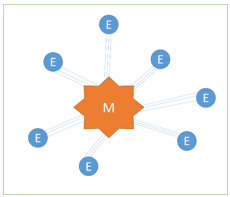
a) Covalent binding
b) Adsorption
c) Entrapment
d) Membrane confinement
View Answer
Explanation: The above diagram represents immobilization by covalent binding. In the diagram, M is carrier matrix and E is enzyme. In this method, the enzyme is linked to the carrier matrix by covalent binding between them. The commonly used matrices are agarose, Sepharose, glutaraldehyde cellulose etc. The diagram of adsorption is represented by,
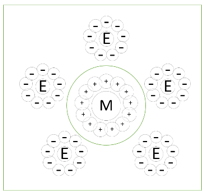
The diagram of entrapment is represented by,
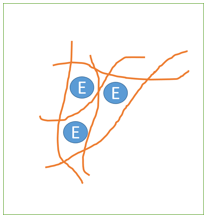
The diagram of membrane confinement is represented by,
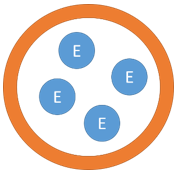
12. The following diagram represents ____________ method of immobilization.
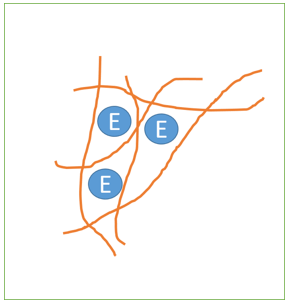
a) covalent binding
b) adsorption
c) entrapment
d) membrane confinement
View Answer
Explanation: The above diagram represents the entrapment method of immobilization. A method in which the enzyme is entrapped within a suitable gel or fiber with the covalent bond being formed or not between the enzyme molecule and the matrix. As a result of non-covalent binding, the enzyme will be in a molecular cage and is known as physical caging.
Sanfoundry Global Education & Learning Series – Enzyme Technology.
To practice all areas of Enzyme Technology, here is complete set of 1000+ Multiple Choice Questions and Answers.
If you find a mistake in question / option / answer, kindly take a screenshot and email to [email protected]
- Check Chemical Engineering Books
- Check Biotechnology Books
- Practice Chemical Engineering MCQs
- Check Enzyme Technology Books
- Apply for Biotechnology Internship
